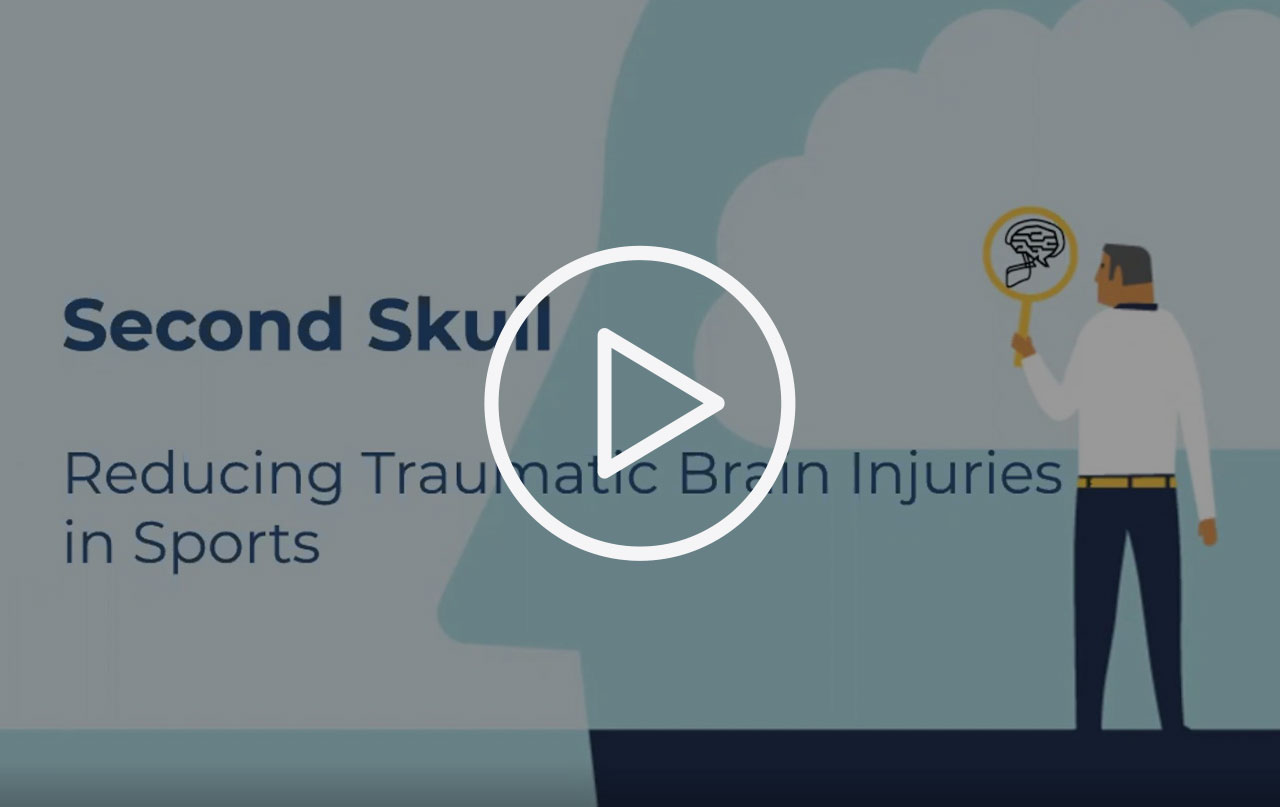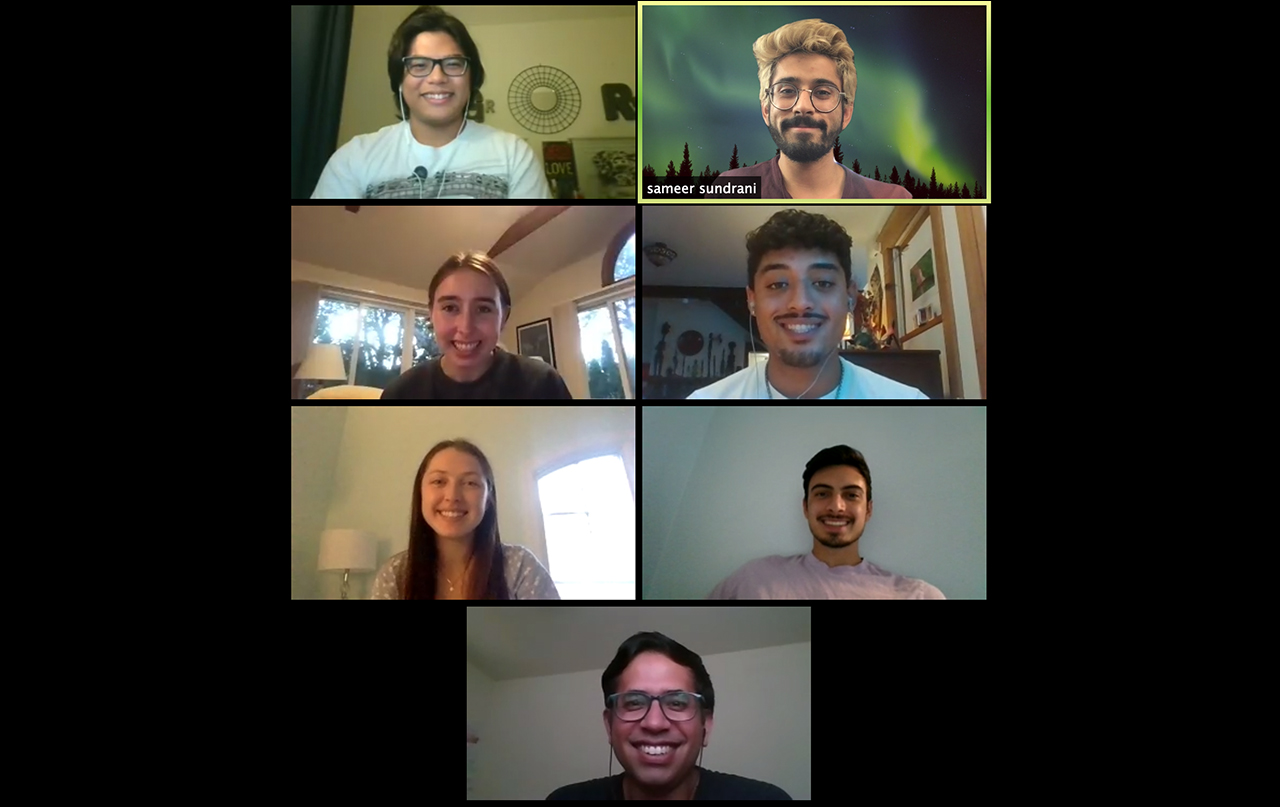Health Technology Showcase
Five Questions and an Elevator Pitch:
Second Skull
 In this short video, members of the Second Skull team explain the need they set out to address and how their solution works.
In this short video, members of the Second Skull team explain the need they set out to address and how their solution works.
1. What is the need your project seeks to address?
Raphael: Mild traumatic brain injuries and concussions are a significant problem in high-impact sports. Even with new helmet technologies, there are over 1.6 million sports-related brain injuries in the US each year. These injuries have a lasting impact that can threaten the athlete’s physical and mental health.
Omeed: There are two primary types of acceleration that cause brain injury in contact sports. Linear acceleration is caused by a direct, perpendicular impact and abruptly stops the brain’s movement through space. Rotational acceleration happens when there is a more oblique impact that causes the brain to ‘twist’ inside the skull. Most injuries generate both types of acceleration - you can imagine if someone gets hit, whether it’s head-to-head, head-to-body, or head-to-ground, it’s fairly unlikely that the collision is going to be only linear. It’s more likely that there’s going to be some sort of head turning or radial motion. The problem is that, even though numerous studies prove that rotational acceleration is the most damaging to the brain and surrounding tissue, most helmets protect only against linear acceleration. Our goal is to design a helmet that can protect against both.
2. How does your solution work?
Isandro: Our design uses multiple layers to reduce linear and radial impact. The first layer is the outer shell, and part of that is a layer we call the ‘crumple zone.’ This structure and the materials it is made from reduce linear acceleration by actually absorbing some of the impact. The second layer is an inner mesh shell that is attached to the person’s head. The inner and outer shells can move independently, a few centimeters in each direction, which reduces the torque and rotational force from a lateral collision. So the helmet takes some of the radial impact and prevents it from being transmitted to the brain. The third part of our design is a spring dampening system between the shells. This absorbs some of the torque as well, reducing impact and vibration and providing another layer of protection against both types of injury.
3. What motivated you to continue working on your project and what activities did you undertake?
Katie: As freshmen and sophomores, we were really motivated by the opportunity to participate in the Biodesign NEXT program. It was empowering for us as younger students to be able to apply the knowledge we gained in our introductory classes and our outside experience to a separate project that’s not just academic, but involves real-world research and product development. We are also really passionate about this need. Right now, the NFL doesn’t test helmets for protection against rotational impacts. Even if our work just raises the visibility of this issue and helps change their testing regimen, that would be huge.
Sameer: The origins of our project are also a little different. We came together as a project team in the undergraduate Stanford Students in Biodesign Club. The normal process is that the club leader recruits students in the fall with the goal of starting some sort of health technology project. The project can be anything and it doesn’t necessarily start with needs-finding or follow the biodesign process.
But this year, our club president talked to Ravi Pamnani, a co-instructor of undergraduate programs at Stanford Biodesign and enlisted him to guide us on our project with the idea of ultimately creating something that’s more real and tangible. With Ravi’s help, we started from the ground-up with needs finding and research. Once we decided to focus on concussions, we worked on the project for most of the 2019-20 academic year. The Biodesign NEXT committee was impressed with our work and invited us to apply for continued mentoring and funding. Once our proposal was approved, we set out to advance our prototype by incorporating the crumple zone, inner mesh shell, and spring system into a CAD model of the helmet, then conduct linear and rotational acceleration tests and iterate from there.
4. What’s one of the most important things you learned from advancing your project beyond the academic year?
Sierra: The pandemic has halted some of our prototyping plans because we couldn’t go into the Biodesign Collab or the Product Realization Lab. So instead, we shifted our focus to do more in-depth research in key areas like intellectual property, product material evaluation, and market research by interviewing football players, coaches, student athletes, and others who are part of the ecosystem. The idea is that when we have access to prototyping facilities, we’ll have a deep understanding of all the dynamics in this space and will be able to hit the ground running.
In the meantime, one of the most important things I’ve learned is how to coordinate efforts and keep the momentum moving forward even though we aren’t all physically in the same space. And that difficulty has also pushed us be more creative in how we search for solutions; for example by reaching out to friends of friends and really networking to do our stakeholder interviews.
 Members of the Second Skull team with advisor Ravi Pamnani
Members of the Second Skull team with advisor Ravi Pamnani
5. What advice do you have for other students who want to become health technology innovators?
Sameer: There’s only so much you can do by researching and being part of class. My advice is to team up with students and do something real, make a project happen. There are so many opportunities here at Stanford and in the Silicon Valley that don’t exist in other places. If you don’t use them, you’re really missing out. This is especially true for undergraduates, who arguably have more time than grad students with other priorities and commitments. This is the time to do something cool and make a product. You have to jump in for real.
Raphael: My advice is don’t be scared. There are people out there who will support you. You might think you don’t know anything - I had no idea what biodesign was coming into Stanford. The Stanford Students in Biodesign club and this project were my first introduction to it. But now I’m very grateful that I took that first step and believed in myself and the team. That’s what has allowed us to reach this stage.
Original Team Members: Sameer Sundrani, Sierra Lore, Raphael Brosula, Isandro Malik, Omeed Miraftab-Salo, Katie Ropers, Sydney Tran
Course: Stanford Students in Biodesign Club
Biodesign NEXT Funding: Awarded for summer and fall quarters 2020
